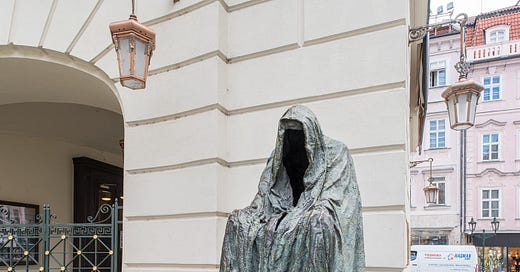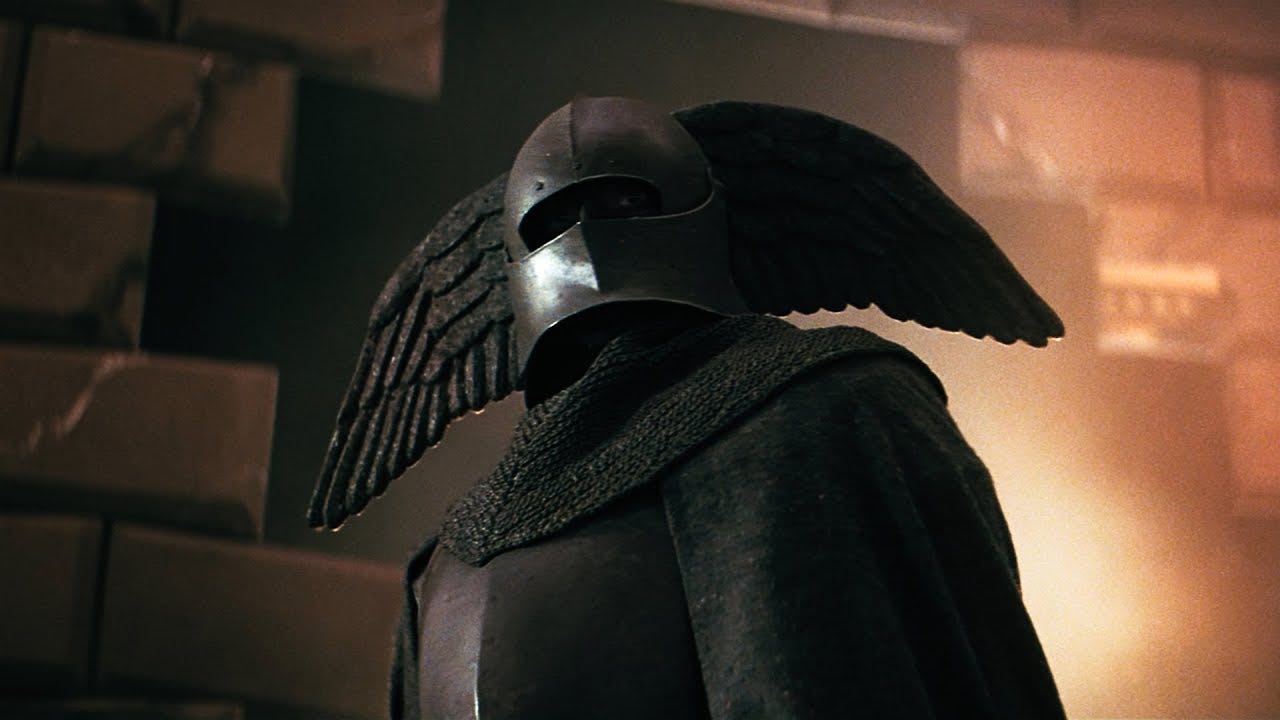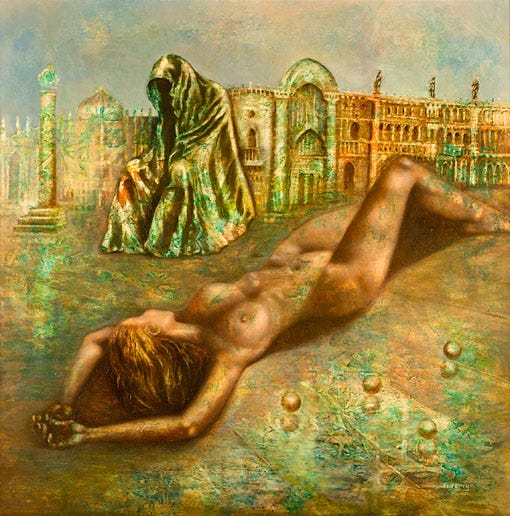‘Horror Moments’ is a weekly series examining horror-inflected scenes and themes in unexpected places. The ‘moments’ are published weekly on Thursdays, and I share articles on the history of magic, theatre, storytelling, and more on Mondays. Catch up with the recent Kate Bush series here and the full back catalogue of horror moments (from Wallace & Gromit to Shakespeare) here. Don’t forget to subscribe!
How do you commemorate a famous ghost, and could a haunted statue follow you home? In this week’s horror moment, we explore one of the clearest examples of a scary scene in opera and examine a fascinating work of art that can perhaps bring this scene to life.
One of the coolest and creepiest statues in the world sits hunched outside the Estates Theatre in Prague. It is human-shaped, wearing a long flowing robe that obscures its whole body. You can just see the outlines of bare hands and feet in the folds of the fabric, but there is no face where a face should be.
It commemorates not a person but a moment in history when Mozart conducted the 1787 premiere of his magnificent opera Don Giovanni in the theatre. The statue is called ‘Il Commendatore,’ after the man whose ghost features in the opera, and it is said that a face has appeared in its dark cloak in photographs taken on the site.
Ghostly Sculptures
‘Il Commendatore’ is one of series of pieces created by Czech artist and sculptor Anna Chromy. Her first version, called ‘The Cloak of Conscience and Tolerance’ was a massive marble statue, carved from a single block sourced from the same Italian quarry which gave Michelangelo his marble for David. That version is so huge that two adults can stand inside it, supposedly for the purposes of prayer and reflection. In this guise, the great white sheet seems suggestive of the Old Testament angels who come cloaked to visit humankind.
The smaller version in Bronze has a much creepier personality, not least because this time it has been named after a ghost, and not just any ghost but probably the most famous spirit in all of opera history.
Haunting Mozart
If you’ve seen Peter Shaffer’s Amadeus (adapted from stage to screen in 1984), you’ll know a little of the story of Don Giovanni already because it features heavily in this fictionalised biopic about Mozart’s life. Amadeus has a brilliant set up: we are hearing the final confession of Mozart’s contemporary composer Antonio Salieri who is admitting that he drove the younger man to an early grave from bitter jealousy, and because he resented God for giving unbeatable talent to a man who led a dissolute and frivolous life.
Shaffer’s Salieri detests and adores his rival in equal measures and ends up weaponising Mozart’s brilliance against him. Noticing that the relationship between Don Giovanni and the Commander (Il Commendatore) mirrors Mozart’s own strained relationship with his father, Salieri starts to literally haunt Mozart by dressing up as the menacing ghost.
The scene where Salieri first notices this frisson between Mozart and his ghost is filmed in the Estates Theatre where the real premiere happened, outside of which Chromy’s sculpture sits.
A Statue Comes Knocking
Strictly speaking, of course, Il Commendatore is not Don Giovanni’s father, but is the father of Donna Anna, a young woman whom the anti-hero was attempting to seduce. In defence of his daughter, he had challenged Giovanni to a duel and had been killed. Later, Don Giovanni and his servant Leporello are passing through a graveyard when a voice from a statue warns him that his laughter won’t last beyond sunrise. On the speaking monument are the words ‘here am I waiting for revenge against the scoundrel who killed me.’ Don Giovanni jokingly invites the statue to dinner and the statue nods its head.
The way the ominous knocking at Don Giovanni’s door heralds the arrival of this statue-turned-ghost can hardly be described as anything other than a horror moment. The libertine’s time has come and no jokes or tricks will save him now. Hell is cleft open and the devils pour out to carry Don Giovanni down to hell.
The librettist (the person who writes the words for an opera) Lorenzo Da Ponte based Don Giovanni on a 1630 play called The Trickster of Seville and the Stone Guest, a title which emphasises the importance of this frightening figure. Whether or not the real Mozart connected the ghost with his own domineering father is moot, but he certainly understood the fearful power of this scene.
There are many other early modern plays that spring to mind as points of comparison. It has the hellish denouement of Doctor Faustus, a ghost-at-the-feast like Macbeth, and a vengeful ghost-father like Hamlet. Oddly enough, the first incarnation of Anna Chromy’s cloaked figure appears in her Hamlet-themed surrealist painting ‘To Be or Not to Be,’ where it seems to turn askance at a prostrated naked woman.
In the world of horror stories, the arrival of the dead man at the door reminds me of the dreadful knocking in W. W. Jacobs’ The Monkey’s Paw. The idea that the statue somehow contains the restless spirit of the dead man provides the same horrid vision of an unstoppable stony force of vengeance as the figures in Edith Nesbit’s Man-Size in Marble.
Man-size in bronze on a street corner in Prague, Il Commendatore sits patiently in the midst of tourists bustling back and forth and submits itself without objection to their selfies as they pause on the way in to watch an opera, perhaps Don Giovanni. If you visit, just be careful that nothing wicked lurks under the cloak of your conscience, or this commemoration of a ghost might follow you home with a heavy tread.
Next week, something has gone horribly wrong in a lighthouse. Until then, happy nightmares everyone!
Horror moments are posted every Thursday and a wide variety of articles exploring the history of magic, theatre, storytelling, and more are published on Mondays.
Remember that you can pay to subscribe for extra benefits or buy me a coffee here to keep me writing. You can also like, share, comment, and recommend to help the substack grow. Thank you!








I've never been too impressed by story monsters, but there are two exceptions. Foremost, the Weeping Angels in Doctor Who, and secondly, ghost stories can sometimes give me goosebumps. As a kid, the original "13 Ghosts" scared me enough I had to go out to the snack bar and buy some candy.
So, ghosts + scary statues? Yikes!
I did not know about Il Commendatore, but now I wonder if he inspired these ghost sculptures at Castello di Vezio above Lake Como! We saw them in person a few years ago and loved them.
https://streetartutopia.com/2025/03/16/ghost-sculptures-in-the-castle-of-vezio-in-italy/